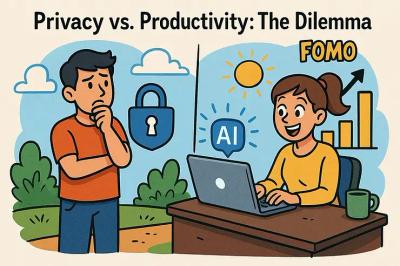AI is Growing But So Are the Risks to Your Personal Data
Introduction
Artificial Intelligence (AI) is transforming the way we work, communicate, and make decisions. From chatbots to automation tools, AI is becoming an essential part of modern productivity. But with this progress comes a growing concern: how safe is your personal data in AI systems?
The Privacy Paradox: AI’s Double-Edged Sword
AI models learn from vast amounts of data, including conversations, documents, and behavioral patterns. Even if you don’t share direct identifiers (name, phone number, etc.), AI can still profile you based on your activity. While manually removing PII from every interaction is an option, it’s time-consuming and impractical, especially for businesses handling large amounts of data.
Data breaches, leaks, and unethical data practices by major companies have already shown that sensitive information isn’t always handled as securely as we assume.
Privacy vs. Productivity: The Dilemma
Privacy vs. Productivity: The Dilemma (and the FOMO)
In today’s digital world, there’s a growing tension between using AI for efficiency and ensuring privacy protection.
- Ignoring AI can mean falling behind. Businesses and individuals who don’t adopt AI risk being less productive in an AI-driven world.
- Using AI without precautions can be risky. Feeding sensitive data into AI tools without safeguards can expose personal and confidential information.
- Compliance laws like GDPR, HIPAA, and CCPA exist, but they are often reactive rather than preventive. They step in after a data breach has already occurred.
- Manually protecting PII is inefficient. While users and organizations can try to remove sensitive data themselves, this is a time-consuming process that isn’t scalable.
Who’s at Risk?
While everyone is vulnerable to AI-driven profiling, some industries face higher stakes when handling personal data:
- Finance – Customer financial records, transaction histories, credit scores
- Healthcare – Patient records, medical histories, prescription data
- Legal & Compliance – Confidential contracts, case files, sensitive communications
- Customer Support & HR – Personally identifiable information (PII) shared in conversations
Organisations handling this data need privacy-first solutions to leverage AI without exposing sensitive information.
How Businesses Can Protect Data Without Losing AI’s Benefits
The key to balancing AI innovation with privacy concerns lies in PII obfuscation and smart data handling strategies. Here are a few actionable steps businesses can take:
- Implement PII Obfuscation Techniques: Before feeding data into AI systems, businesses should use encryption, tokenization, and anonymization techniques. This ensures AI models never directly process raw personal information, reducing compliance risks.
- Adopt a Privacy-by-Design Approach: Instead of treating privacy as an afterthought, integrate privacy-first principles into every AI-driven workflow. Build AI models with minimal data collection and ensure transparent consent mechanisms for users.
- Use Federated Learning to Train AI Without Exposing Data: Federated learning allows businesses to train AI models across decentralized devices without moving sensitive data to a central location. This reduces exposure while still enabling AI to learn from diverse datasets.
- Apply Differential Privacy for Added Security: Differential privacy techniques introduce mathematical noise into datasets, preventing AI from identifying individuals while still allowing useful insights. This ensures data remains statistically valuable but privacy-safe.
- Utilize Synthetic Data for AI Training: Instead of real customer data, companies can generate synthetic datasets that retain the statistical properties of original data while eliminating direct PII exposure.
- Stay Ahead of Regulatory Compliance: Waiting for data privacy regulations to catch up is a risky game. Instead, businesses should proactively comply with frameworks like GDPR and HIPAA, even if they aren’t currently required to.
- Educate Employees & Customers on AI Privacy: A company’s approach to AI privacy is only as strong as its weakest link. Employees handling data should receive continuous training on privacy policies, and customers should be informed about how their data is being used.
Conclusion: Future-Proofing AI-Powered Businesses
AI is an unstoppable force in modern business, but privacy risks don’t have to be a byproduct of progress. By implementing PII obfuscation, following privacy-by-design principles, and embracing AI security best practices, businesses can enjoy the best of both worlds, innovation and trust.
The question is no longer whether businesses should prioritise data privacy, but rather how quickly they can adapt to do so effectively.
Would love to hear your thoughts! How do you approach privacy when using AI tools?
#DataPrivacy #AI #CyberSecurity #PIIProtection #AICompliance #PrivacyMatters


